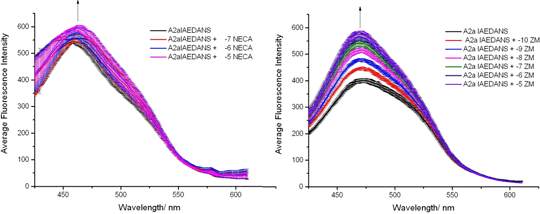Print version
Search Pub Med
Antagonist-dependant changes in the conformation of a styrene maleic acid co-polymer (SMALP)-solubilised adenosine 2a receptor labelled with IAEDANS
Membrane proteins are normally solubilised with detergents, but these perturb the properties of the protein. To overcome this, we have previously reported the solubilisation of the adenosine 2a receptor (A2aR) using (SMALPs) [1]. We have also reported that, using endogenous tryptophan fluorescence, the antagonist ZM241385 produced a concentration-dependent change in emission, suggesting that the receptor is stabilised in a form distinct from the inactive ground state [2]. To further investigate this, we have labelled the receptor with the fluorescent reporter IAEDANS. An N-terminal His-tagged A2aR with the mutations A231C and I106W was purified from Pichia pastoris as described previously [1, 2]. The receptor was labelled with IAEDANS and fluorescence intensity was recorded with excitation at 340 nm [3]. The receptor was challenged with increasing concentrations of the agonist NECA and the antagonist ZM241385. Concentration-response curves were fitted to give Emax, minimum and pEC50
Fig 1. Fluorescence emission spectra of the IAEDANS-labelled A2aR challenged with NECA (left) and ZM241385 (right). Values are means ± sem of three independent experiments.
ZM241395 caused a large increase in fluorescence intensity, with a pEC50 of 8.74 ± 0.32 (n=3). By contrast, NECA was caused a much smaller change. This is similar to our previous results using endogenous tryptophan fluorescence [2], although it was substantially less potent in those studies (pEC50 7.00 ± 0.10, n=3). This gives further evidence that SMALPs stabilise the A2aR in a form that is closer to the agonist-stabilised active state rather than a fully inactive receptor. This work was supported by BBSRC grants BB/I019960 and BB/I020349. References 1. Jamshad, M et al (2015). Bioscience Rep 35: pii: e00188. 2. Routledge, S et al (2014). Proceedings of the British Pharmacological Society at http://www.pA2online.org/abstracts/Vol12Issue3abst052P.pdf 3. https://tools.thermofisher.com/content/sfs/manuals/mp00003.pdf1
|



